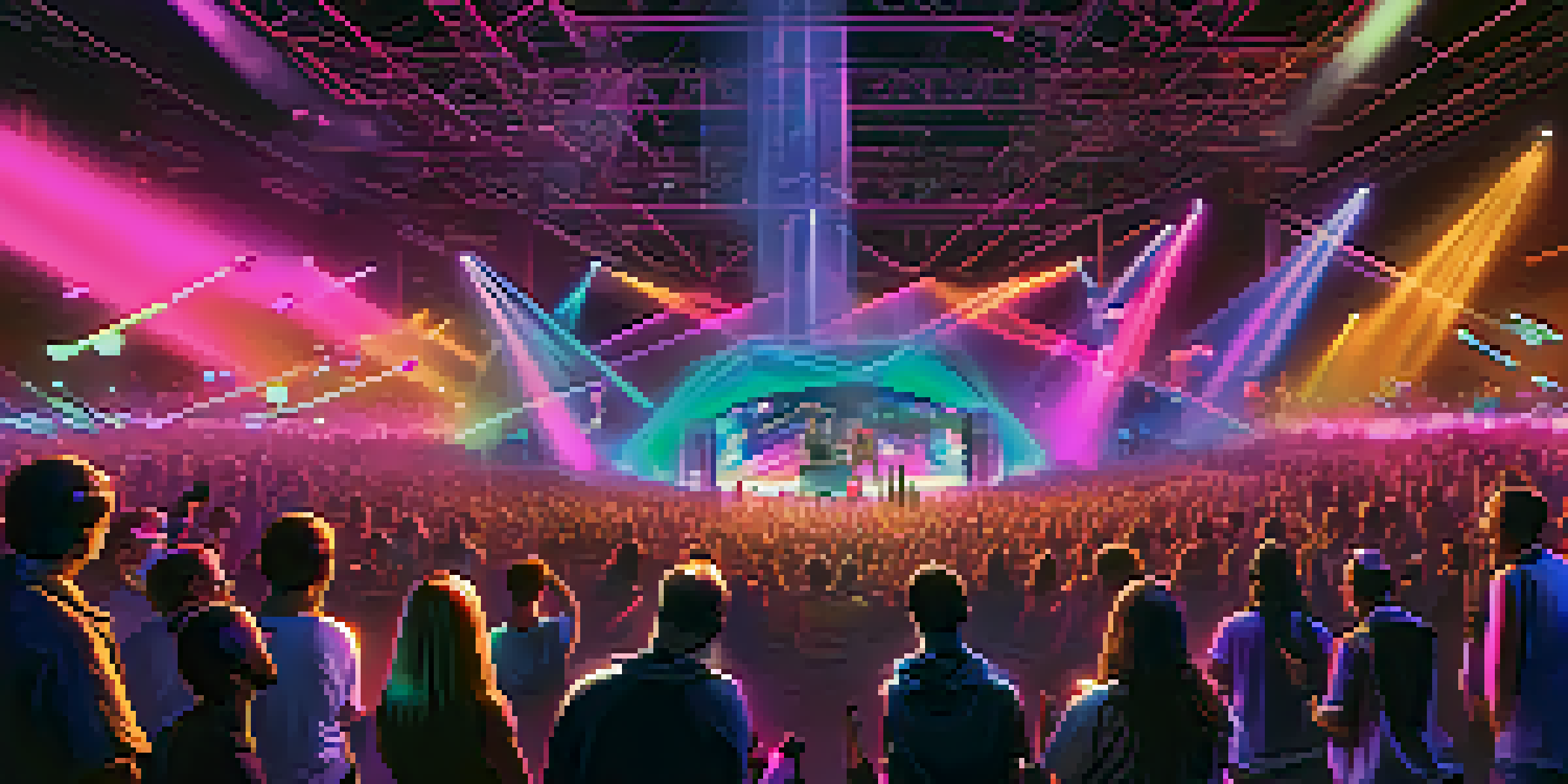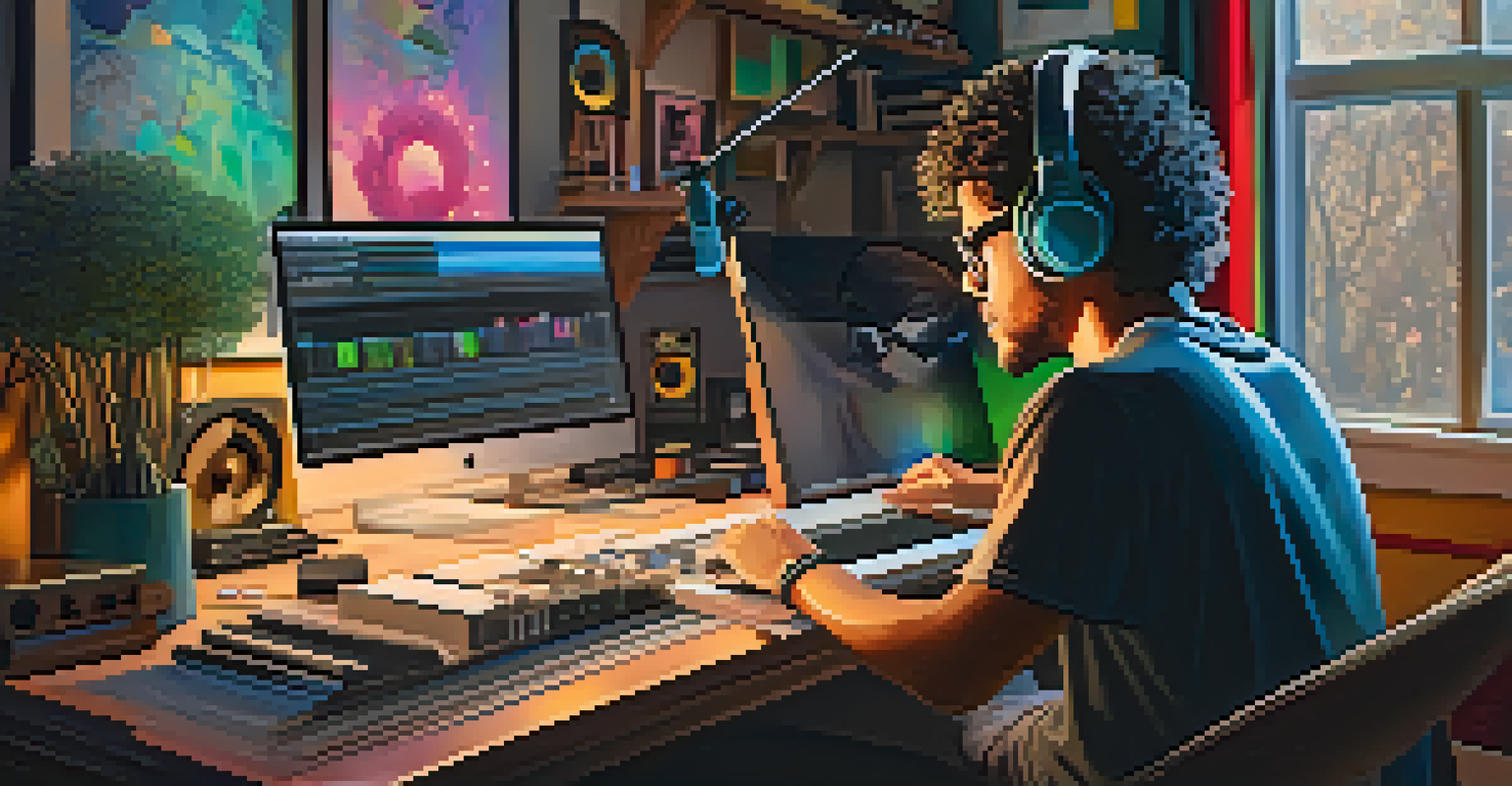The Impact of NFTs on Music Distribution and Accessibility

Understanding NFTs and Their Role in Music
NFTs, or non-fungible tokens, are unique digital assets verified using blockchain technology. In the music industry, they provide a new way for artists to sell their work directly to fans. Unlike traditional music distribution, NFTs allow musicians to retain more control over their creations and profits.
The future of music is not about selling records, it's about building a community.
For example, an artist can create an NFT of a song or an album, which fans can purchase, ensuring that the artist receives a larger share of the revenue. This direct-to-fan model not only promotes authenticity but also fosters a deeper connection between artists and their audience. The unique aspect of NFTs lies in their ability to prove ownership and scarcity, which can enhance the perceived value of music.
As artists explore this innovative medium, the potential for creativity expands. Musicians can combine audio, visuals, and even exclusive experiences into a single NFT, providing fans with a richer experience. This shift signifies a move towards more personalized and engaging music consumption.
Enhancing Revenue Streams for Artists
Traditionally, musicians have relied heavily on streaming platforms for income, often receiving only a fraction of a cent per stream. NFTs offer a promising alternative, allowing artists to sell their music as unique digital collectibles. This can significantly boost their revenue, especially for independent artists who may struggle to gain traction through conventional channels.

Take, for instance, the artist Grimes, who famously sold NFT artwork and music for millions. This example illustrates how artists can maximize their earnings by leveraging the unique nature of NFTs. By cutting out intermediaries, musicians can engage in more profitable transactions directly with fans.
NFTs Empower Artists and Fans
NFTs give artists greater control over their music and create direct connections with fans.
Moreover, NFTs can provide ongoing revenue through resale royalties, meaning artists can receive a percentage every time their NFT is sold in secondary markets. This creates a sustainable income stream, encouraging artists to produce more work and engage with their fanbase.
Expanding Accessibility to Diverse Audiences
One of the most exciting aspects of NFTs is their potential to broaden music accessibility. By utilizing blockchain technology, NFTs can reach global audiences without the barriers that often accompany traditional distribution methods. This means that fans from all over the world can discover and support artists from various genres and backgrounds.
Creativity is intelligence having fun.
For instance, an emerging artist from a small town can create an NFT and share it with a global audience through online platforms. This democratization of music distribution allows for a more diverse array of voices to be heard. It challenges the dominance of major labels and opens doors for independent musicians to thrive.
Additionally, NFTs can include special perks, like exclusive access to concerts or behind-the-scenes content, enhancing the overall fan experience. This blend of accessibility and exclusivity creates a unique ecosystem where fans feel more connected to the artists they love.
NFTs as a Tool for Fan Engagement
Engagement is key in today's music landscape, and NFTs can significantly enhance this connection. By offering fans unique experiences tied to their favorite artists, NFTs encourage deeper interactions. For example, an artist might release an NFT that grants holders access to a private virtual concert or Q&A session.
This type of interaction creates a sense of community among fans, as they gain exclusive access to events that aren't available to the general public. It transforms fans from passive listeners to active participants in an artist's journey, making them feel valued and connected. The emotional investment fans make in these NFTs often translates into a stronger loyalty to the artist.
New Revenue Opportunities via NFTs
By selling music as unique digital collectibles, artists can significantly boost their earnings and establish sustainable income streams.
Ultimately, NFTs provide a platform for artists to express their appreciation for their fans, rewarding them with unique experiences. This strategy not only fosters a dedicated fanbase but also encourages word-of-mouth marketing, further amplifying an artist’s reach.
The Challenges of NFT Adoption in Music
Despite the exciting potential of NFTs, there are challenges that artists and fans face in adoption. For one, the technical aspects of NFTs and blockchain can be daunting for those unfamiliar with the technology. This barrier can hinder artists from fully embracing the NFT space, particularly those who may not have the resources to navigate the complexities involved.
Moreover, the environmental concerns surrounding blockchain technology cannot be overlooked. The energy consumption required for NFT transactions has raised questions about sustainability in the music industry. As artists become more aware of these issues, they must weigh the benefits of NFTs against their environmental impact.
Lastly, the market for NFTs can be volatile, with prices fluctuating dramatically. Artists may find it challenging to predict the value of their work in this new landscape. Navigating these challenges will be crucial for artists and fans as they explore the future of music distribution through NFTs.
The Future of Music Distribution with NFTs
As the music industry evolves, NFTs are poised to play a pivotal role in shaping its future. This technology has the potential to redefine how artists distribute their music and connect with audiences. With more artists starting to explore NFTs, we may witness a significant shift in the traditional music landscape.
Looking ahead, we can expect to see more innovative uses of NFTs in music, such as collaborations between artists or the creation of new genres. The ability to combine different forms of art within an NFT also opens up exciting possibilities for cross-genre experimentation. This evolution could lead to the emergence of entirely new music experiences.
Broader Access to Diverse Music
NFTs democratize music distribution, allowing artists from various backgrounds to reach global audiences without traditional barriers.
Furthermore, as more consumers become educated about NFTs, the demand for unique digital music assets will likely increase. This growing interest could prompt mainstream platforms to adopt NFT features, making the technology more accessible to a broader audience. The future of music distribution may very well be shaped by the creativity and adaptability of artists engaging with NFTs.
Conclusion: Embracing the NFT Revolution in Music
The impact of NFTs on music distribution and accessibility is undeniable. As artists harness this technology, they gain unprecedented control over their work and a direct line to their fans. This transformative approach not only reshapes revenue models but also fosters a more intimate connection between musicians and their audience.
While challenges remain, the potential for NFTs to revolutionize the music industry is vast. Artists who embrace this change may find new opportunities for creativity, engagement, and financial sustainability. As we move forward, the evolution of music distribution will continue to be influenced by the innovative spirit of those willing to explore the possibilities of NFTs.

In the end, the key to success in this new landscape will be adaptability. As artists and fans navigate the exciting world of NFTs, those who embrace change and explore new avenues for expression will thrive in this dynamic environment.